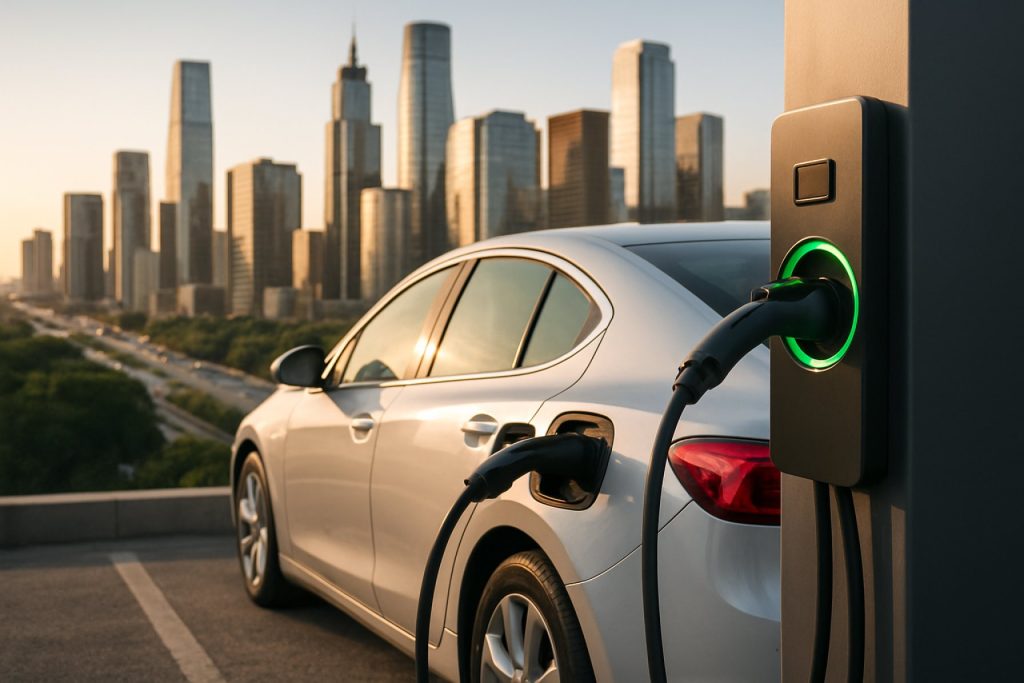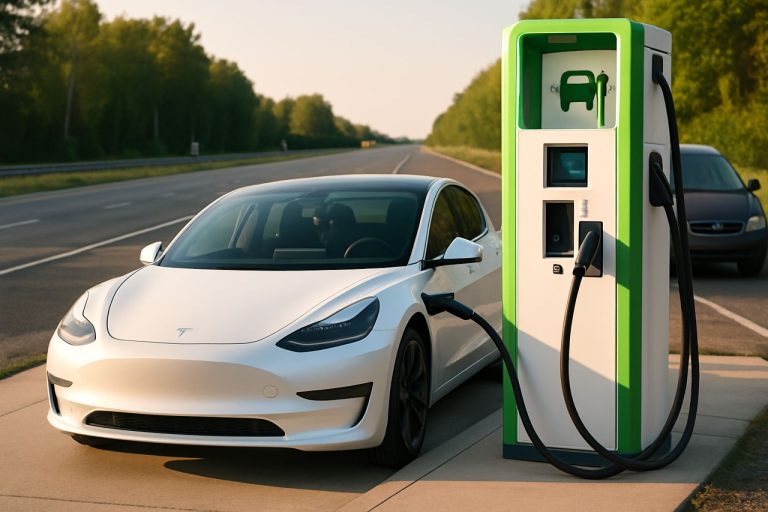
- EV battery production is surging, with global output surpassing 1,000 gigawatt-hours and expected to keep rising through 2030.
- Lithium iron phosphate (LFP) and solid-state batteries are driving innovation, offering enhanced safety, lifespan, and energy density.
- Asia, led by China and South Korea, dominates battery manufacturing, while Europe, the US, and India are rapidly expanding capacity.
- Environmental concerns over mining and e-waste are spurring the growth of recycling initiatives and closed-loop supply chains.
- Government policies and industry investments aim to make electric vehicles affordable and sustainable, pushing cities toward cleaner air and net-zero targets.
- The shift to electric mobility is reshaping global transport, with challenges ahead but clear momentum toward a greener, electrified future.
Steel plants roar and robots glide through glinting new gigafactories as the global race to fuel electric vehicles surges forward. By 2030, the world is poised not just for a transformation—but a revolution—in how we move, thanks to an unprecedented boom in EV battery production. The stakes are nothing less than the future shape of urban life and the health of the planet.
Beneath the sleek shells of tomorrow’s cars, powerful new batteries hum with promise. The market has already vaulted above 1,000 gigawatt-hours per year—a leap that would have seemed unthinkable just five years ago. Engineers feverishly refine lithium-ion chemistry, but the real excitement simmers around lithium iron phosphate (LFP) and solid-state batteries. LFP packs now run quieter, safer, and longer than ever. Heavyweights like Tesla champion this technology not just for luxury models, but for cars meant for millions. Meanwhile, a vanguard of industry leaders push solid-state batteries closer to reality; prototypes promise up to 50% more energy density and ax charging times, ticking all the boxes for restless commuters and adventurous road trippers.
Asia stands at the helm of this tidal shift, with China’s CATL and South Korea’s LG Energy Solution expected to hit a combined annual output of 500 gigawatt-hours by next year alone. Giga-initiatives across Europe and the US underscore the intensity of the contest. Countries like India are scripting their own battery stories, leveraging government incentives to turn ambition into action at breakneck speed.
Yet, innovation does not come without questions. Headlines flash with environmental concerns—mineral mining’s scars, carbon generated in manufacturing, the gathering e-waste storm. In response, a growing alliance of companies reengineer their supply chains for a world that craves both performance and conscience. Trailblazers such as Umicore and Redwood Materials expand closed-loop “urban mining”: stripping old batteries for a second life, slashing demand for freshly mined lithium or cobalt. The industry’s goal is to make these once-rare minerals circulate endlessly, shrinking the carbon footprint of every electric mile.
For cities smothered in smog, this surge in battery capacity holds tantalizing potential. Policymakers across continents double down with net-zero mandates and green subsidies, seeing electrified public transport and cleaner air as both a moral imperative and an economic windfall. The era of the dirty combustion engine, once thought impossible to end, now teeters on the brink.
The march to 2030 won’t be smooth—supply chains remain fragile, and scaling transformative technologies is a marathon, not a sprint. Yet the trajectory is clear. As production soars, costs drop, and innovations swell the range and safety of EVs, electric mobility edges out of luxury and into everyday life. Young workers in Pune, factory owners in Texas, and families in Berlin will all soon feel the electric pulse reshaping their commutes and communities.
This is more than an engineering story. It’s a global sprint toward a cleaner, electrified urban future—and it’s gathering speed. The crucial question now: who will win the race, and how fast can the world adapt?
Discover more about the future of clean energy at Tesla and the latest advancements in battery materials at Umicore.
Key Takeaway: As battery technology and production rapidly advance, the world accelerates toward an electrified, sustainable future—where the road ahead is limited only by our vision and velocity of progress.
Battery Boom 2030: The Hidden Truths and Smart Hacks Behind the EV Revolution
The Global Gigafactory Surge: More Than Meets the Eye
The electrification of mobility is outpacing predictions, with gigafactories—massive battery plants—springing up worldwide. But beyond high-profile headlines, here are critical and lesser-known facts, market insights, industry trends, and expert answers about the EV battery revolution.
—
1. Battery Tech Showdown: LFP vs Solid-State vs Lithium-Ion
– LFP (Lithium Iron Phosphate):
– Safety: LFP cells are thermally stable, reducing fire risk compared to nickel-based batteries (source: International Energy Agency).
– Longevity: They offer 2,000–3,000 charging cycles (vs 1,000–2,000 for regular lithium-ion).
– Cost: Lower due to lack of cobalt/nickel, crucial minerals with volatile prices and supply chain issues.
– Limitation: Lower energy density (~150-180 Wh/kg) means potentially shorter range.
– Solid-State Batteries:
– Breakthrough Potential: Can reach 400 Wh/kg, doubling range or halving battery weight.
– Fast Charging: Potential for 80% charge in under 15 minutes.
– Current Limitation: Large-scale manufacturing remains unproven and expensive (Nature Reviews Materials 2022).
– Safety: Further reduced fire risk due to solid electrolytes.
– Lithium-Ion Chemistry:
– Dominant Today: Over 90% EVs still use this, but gradual shift expected by 2030.
– NMC (Nickel–Manganese–Cobalt) family still delivers best performance for long range/high power but at higher cost and sustainability concerns.
Pro Tip: If you want an EV for city commuting, LFP models are often cheaper and more durable.
—
2. Supply Chain Security & Sustainability: More Than Recycling
– Closed-Loop Urban Mining: Pioneers like Umicore and Redwood Materials are setting up recycling systems capable of recovering over 95% of battery metals—turning e-waste into a resource, not a problem.
– New Extraction: Direct Lithium Extraction (DLE) reduces water usage and toxicity compared to traditional mining.
– Cobalt/Copper Alternatives: Tesla and OEMs are rapidly moving to cobalt-free chemistries to avoid ethical issues around mining (Amnesty International, 2023).
How-To: Battery Recycling
1. Drop old batteries at certified collection points or dealerships.
2. Verify recyclers are R2 or e-Stewards certified for responsible handling.
3. If possible, ask for documentation showing your battery was recycled.
—
3. Gigafactory Expansion: Regional Race and Geopolitical Calculus
– Asia’s Dominance: China controls 75% of cell manufacturing, with CATL and BYD leading.
– Europe/US Push: VW, Northvolt (Sweden), Tesla GigaTexas, and others are racing to localize supply for energy independence.
– India’s Ascent: Targeting 50 GWh/yr by 2030 with government-backed “Production-Linked Incentives” (PLI).
Market Forecast: BloombergNEF forecasts EV battery market growing from $41B in 2023 to over $116B by 2030.
—
4. Environmental, Social & Policy Impacts
– Emission Reductions: An EV in the EU emits 3x less CO2 over lifetime compared to combustion cars, even accounting for current grid mix.
– Urban Health: Widespread EV adoption may reduce city air particulates by up to 30% by 2035, saving thousands of lives.
– Policy Trends: EU’s 2035 ban on new ICE (internal combustion engine) sales; US EPA targets 67% new car sales to be electric/hybrid by 2032.
—
5. What Consumers Ask Most
– Are EVs really greener when grid is not 100% renewable?
Yes, battery EVs generally emit less over their lifespan, and with the grid getting greener, the gap widens.
– Will battery prices keep dropping?
Yes. Industry estimates (IEA, BloombergNEF) project battery costs could fall below $70/kWh by 2030, down from $200+ today.
– Is charging infrastructure catching up?
Charging networks are growing: Europe’s IONITY, US Tesla Supercharger expansion, and Shell/EnelX home/urban fast-charging solutions.
– Are there security and cyber risks?
As batteries get smarter (BMS, over-the-air updates), cybersecurity investment is rising—but users should keep firmware updated and enable 2FA where possible.
—
6. Reviews, Specs & Pros/Cons
– Top LFP EVs (2024):
– Tesla Model 3 RWD: ~272 miles range, LFP pack.
– BYD Seal: 82 kWh battery, advanced efficiency.
– MG4 EV: Affordable, robust LFP battery.
– Solid-State Prototypes:
– Toyota’s 2025 model: Promises 620-750 miles range, 10-min charge.
Pros:
– Lower operating and maintenance costs.
– Improved safety and reliability.
– Quiet, smooth ride; instant acceleration.
Cons:
– Range still depends on climate and driving habits.
– Upfront cost can be high before incentives.
– Charging depends on location/infrastructure.
—
7. Life Hacks & Quick Tips for the Electric Transition
– Optimize Battery Life:
Charge between 20-80%, avoid frequent fast-charging, and update vehicle software regularly.
– Incentives:
Use government rebates—check eligibility at your national energy or transportation agency.
– Second-Life Use:
Old EV batteries can be repurposed for home solar storage—ask your installer about compatible options.
—
The Bottom Line: Actionable Recommendations
Charge toward the future by:
– Considering an LFP-equipped EV for practical urban needs.
– Supporting certified battery recycling programs and responsible manufacturers.
– Staying updated on new battery chemistry breakthroughs (solid-state, sodium-ion).
– Leveraging local and national clean energy incentives for upfront savings.
– Following trustworthy leaders in the field like Tesla and Umicore for innovation updates.
The electric age is advancing fast. Join it now—drive cleaner, save money, and help shape the urban future.
Keywords: EV battery boom, gigafactory, electric vehicles, LFP vs solid-state, battery recycling, battery sustainability, battery market trends, EV charging, EV incentives, urban mining, battery pros and cons, battery security, clean energy future.



